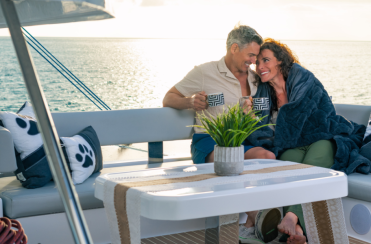When attending a boat show or looking at manufacturer’s pictures online you may not get the full experience of how it feels to sail the boat in real life. Real sailing is understood on that dark night time watch from 2am to 5am, when you are sitting alone at the helm of your catamaran.
When shopping for a catamaran you should have a list of criteria, some of which will be non-negotiable– interior layout, sail plan, storage space, the list can go on. But if the design and layout of the helm is not on your list, it should be.
Perfecting the Layout
When designing a catamaran, you want to ensure that an enormous amount of attention has been given to the layout and set up of the helm. In the design phase, each new Leopard model gets a ‘mock-up’, built mostly out of plywood, which includes the helm-seat, steering wheel, winch positions, sheet angles and steps leading to and from the helm (see photo left).
The reason we do this is the fact that when you are sailing, you will find yourself at the helm or close thereto most of the time. Yes, you will be on autopilot the majority of times but when it comes to reefing, can you do it by yourself or do you need a second pair of hands? Do you need to leave the helm to go on deck? During the “mock-up” stage when designing a new model, these are all questions that are asked to ensure that we build a comfortable and efficient catamaran that can do all of the functions necessary for single-handed sailing.
Leading the pack of innovation
Leopard Catamarans were the first catamarans designed with the central winch pod. The original concept from the 90’s of having a winch on the coach-roof on the port as well as the starboard side was replaced with the innovative winch pod: 2 winches next to the helm and a turning block for the port side genoa sheet.

The next innovative feature for cruising catamarans was single line reefing for the main sail. A reef line that originates at the clew of the sail is led through the reefing eyes on the sail, to the base of the mast and back to the helm / winch pod. Of course this is a feature for both reef 1 and 2. If you need to reef (remember that night time watch from 2am -5am…), you can do it while sitting in your helm-seat, by yourself.
Protection from the elements
Another consideration when purchasing a catamaran is the importance of protection from the elements. Are you protected from the sun, wind and rain at the helm? A flybridge helm on top of the coachroof might look wonderful in pictures and at a boat-show, but who will be sitting there from 2am-5am, exposed to the elements? Although we wish it could always be smooth sailing, this is never the case. Where are the winches located on the flybridge? Do you need to move other people out of the way to do any sail operations? How is enhanced boat movement in the ocean on top of the coach-roof? How high is the center of gravity?
All Leopard catamarans have a hybrid helm. The helm is not in the cockpit and not on top, but in between with a separate hardtop over the helm. This way you can keep an eye on your surroundings, while not being excluded from the party and your crew in the cockpit or salon. On the Leopard 50, the captain is able to stay connected with guests in the cockpit and guests on the flybridge/ lounge. Click here to see a visual.
We don’t compromise on comfort, and we are all sailors at heart: we don’t want to sit under the merciless sun , nor do we want to have sidewind rain or hail battering our faces if the weather turns sour. The hardtop over the helm on any Leopard catamaran can be completely or partially enclosed, while maintaining excellent visibility and no noticeable difference in windage. That wide open flybridge helm I mentioned before that looked so good at the boat show will feel cold and lonely during those dark hours at night, and on a sunny day the exposure can be cruel.
See for yourself
Before you make a big decision, you should take the opportunity to see and sail the model you are considering to purchase. Take the time to sit at the helm, lean back, stretch your legs next to the steering wheel (yes, we also do that during the conception phase!), reach out to the clutches and winches for the sheets, check out the location of your engine instrument panels. Can you see the alarm light if it were to come on? Can you adjust the course on your autopilot without getting out of your seat?
The helm is the center of operations on a Leopard Catamaran, and just like all roads lead to Rome, all lines lead to your helm!



